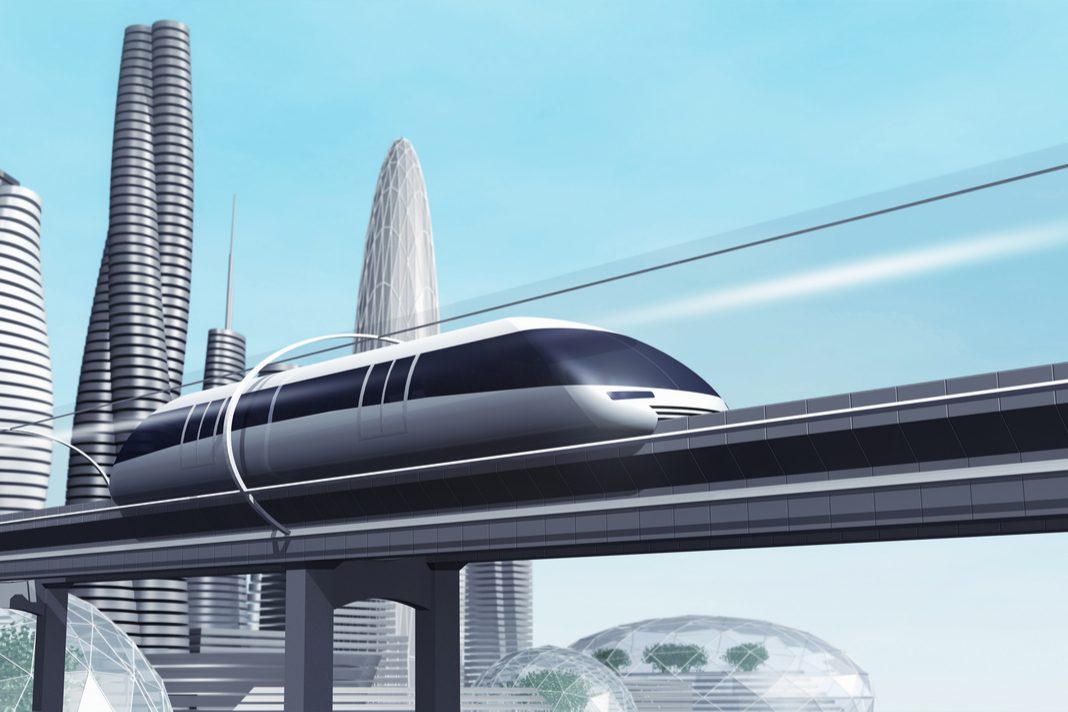
120 years ago, the Russian edition of Science and Life published material on the future of railways - experts ’very bold forecasts came true with accuracy: even then, the inevitable death of steam traction was predicted, the transition to electricity, high-quality railways and high-speed transportation modern "Peregrine Falcons". These forecasts were based on the advanced developments of that time, and were not “finger to heaven” predictions from science fiction writers. Let us also try to look into the future of railways, evaluating the most modern promising and experimental developments. So what will the railways become?
More popular
Rail transport fits perfectly into the global environmental concept of development. While skeptics argue about the ecological track of Greta Tunberg’s travels, a sailing yacht of which is followed by planes with journalists and crew to get the yacht back without Greta herself, the states continue to systematically tighten the standards for the emission of harmful substances by transport. Strict regulations have not yet reached aviation, but the ban on the production and sale of ICE cars seems to be just around the corner.
Since trains remain the optimal way to transport a large number of people in relative comfort, in the context of an increasing tightening of the ecological framework, their popularity will only grow. At the same time, we are not talking about the mandatory expansion of the railway network - even in developed countries there is a tendency to reduce the length of railways, and instead of branched obsolete non-electrified tracks, high-speed lines between large cities are built - with a smaller mileage, their throughput and demand are many times greater. An exception is China, where new roads are actively being built and existing ones are electrified.

The Chinese railway scheme can only be envied - from north to south and from west to east you can get on high-speed trains. Between all significant cities with a million-plus population, trains travel at speeds of at least 200 km / h. Source: Howchou / Wikimedia
The recent launch of the Moscow Central Diameters is one of the steps to increase the transport accessibility of the cities of the Moscow region and, in the future, the districts of New Moscow. An undeniable fact testifies in favor of the veracity of this statement: urbanization inevitably leads to the enlargement of cities and the creation of huge agglomerations, which can only be moved quickly by rail. The Swedish professor Kjell Nordstrom became famous for his frightening prognosis of regrouping the world population into the 600 largest cities . Imagine Moscow, which ends not in the Moscow Ring Road, but at least in the area of the Small Moscow Ring (and that’s all) with a diameter of about 100 km — trying to cross such a giant city by car is simply pointless: it will take at least half a day, while the train will cope with all the stops in a couple of hours.
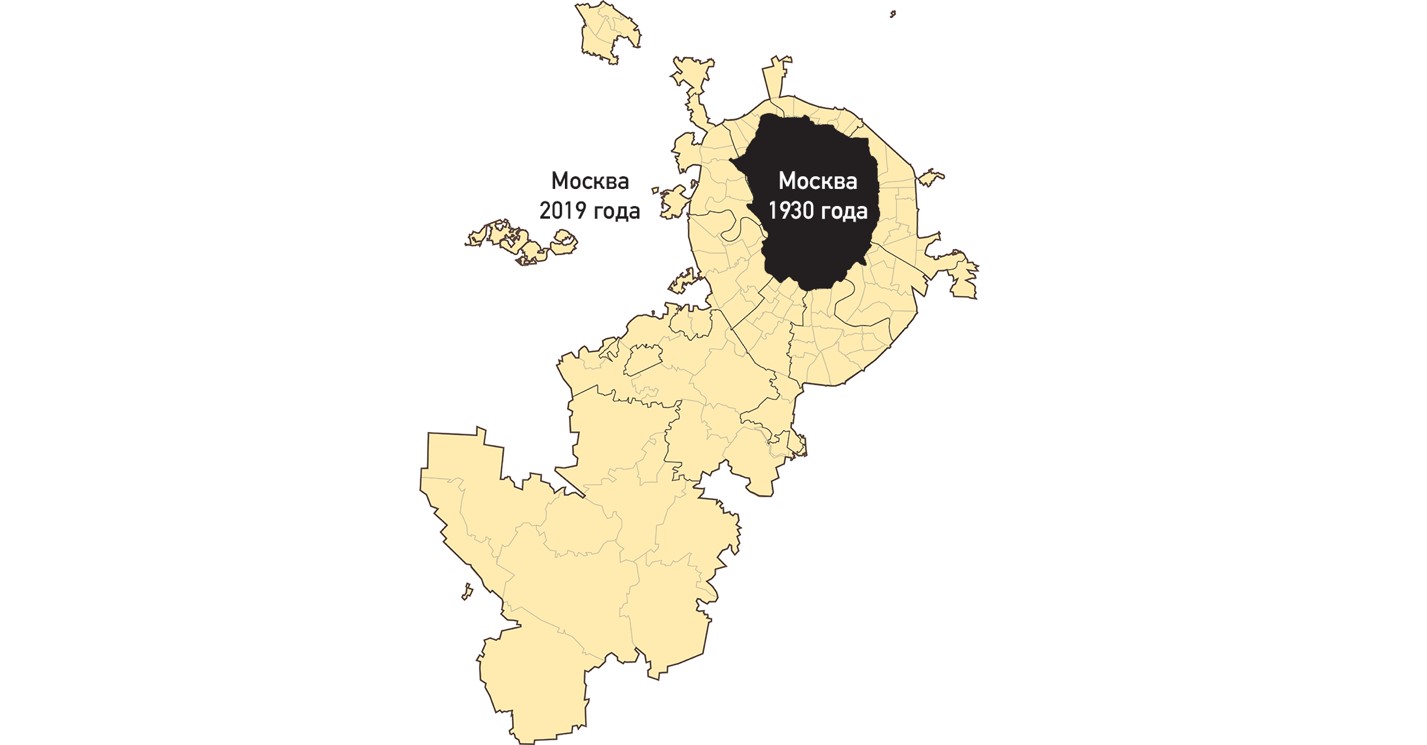
Comparison of the sizes of Moscow in the 1930s and 2019. The districts of New Moscow in the southwest will inevitably be built up, and it will be possible to get to the old city from there by train. Source: Toshiba
More speed
In the field of increasing train speed, the most illustrative example is China as a country that, over two decades, not only significantly increased the average speed of trains, but also created its own industry of high-speed rail traffic, and now it is completely leading the world.
In 1978, Chinese politician Deng Xiaoping visited Japan, which he considered a very progressive country with a rapidly developing economy, with which to take an example. The Chinese guest was greatly impressed by the high-speed Shinkansen passenger train, which was already traveling at a speed of up to 220 km / h at that time. Among the reforms laid down by Deng Xiaoping later there was a complete renewal of the railway track in the country and the development of its own electric trains.
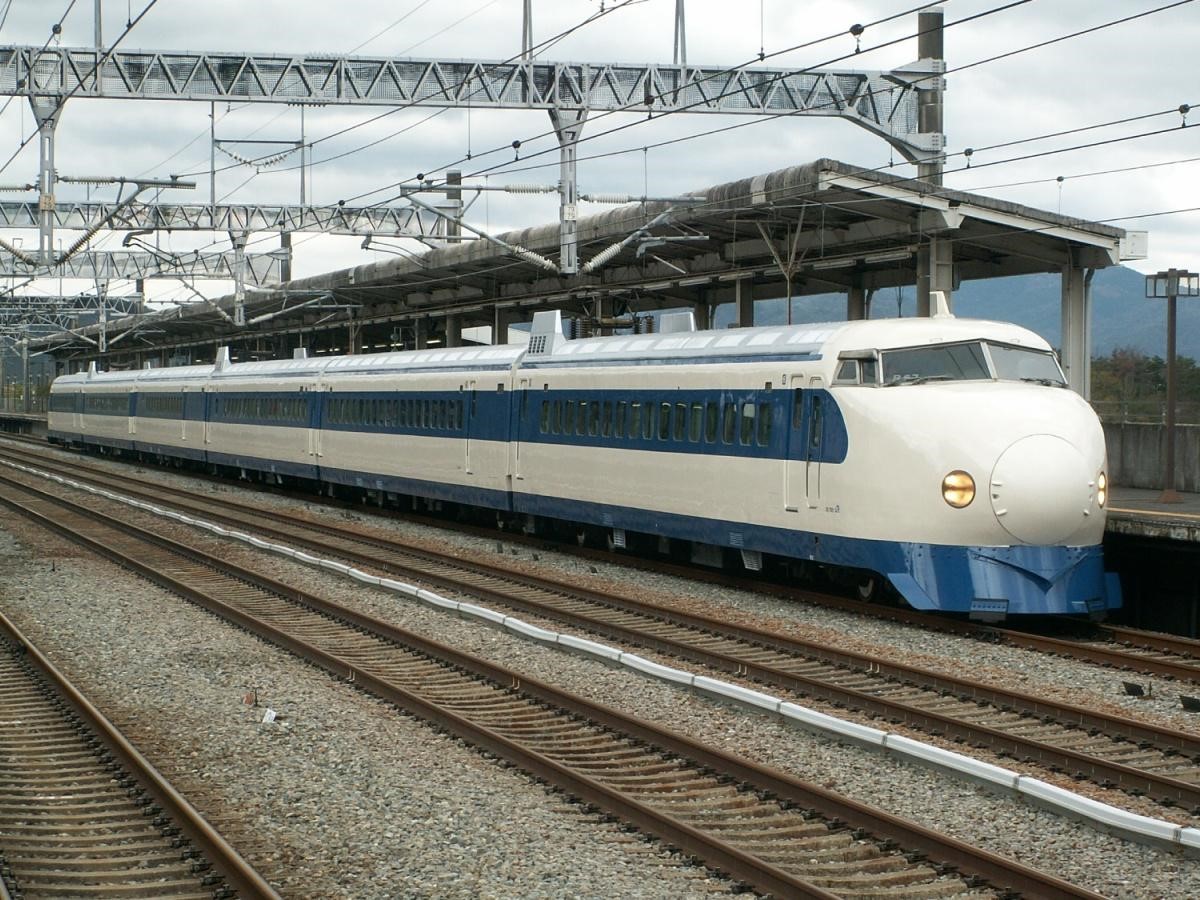
The same Shinkansen of series 0, which made an indelible impression on Deng Xiaoping, there are archival shootings on the Internet that show the undisguised surprise of the President of the PRC from the fact of such a quick train ride. Source: Nadate / Wikimedia
By 1990, the program for the construction of the first high-speed line was approved, and from 1997 to 2007, in several stages of modernizing existing routes, the average speed of passenger trains in the country was increased from 43 to 70 km / h - it seems to be a little, but in fact it is a huge breakthrough , especially for two five-year plans. For example, in Russia, the average speed for 2017 was 57 km / h, and according to the calculations of the Federal Passenger Company, by 2031 it can rise to 65 km / h, but this is not accurate. Is growth of only 8 km / h in 15 years a little? As you can see, in 1930 the average speed in the USSR was 31 km / h.
It is impossible to simply raise the allowed speed limit to improve statistics - it is necessary to prepare the infrastructure. At a minimum, lay a weld-free path, consisting of long lashes of welded together rails. The absence of joints, which are usually reported to us by the measured knock of wheels, reduces resistance to the movement of the train, extends the life of the track and affects the comfort of passengers.

The junction of the rail jointless track. Our grandchildren or great-grandchildren may never know the measured knocking of the wheels of a night train: there is nothing to knock about. Source: LosHawlos / Wikimedia
This modernization of tracks significantly increases the allowable speed limit. In 10 years, the very same China renewed 7,700 km of the railway, adapting it to traffic at a speed of 160 km / h, and in just five years, in the 2010s, 12,000 km were built for high-speed communication. And the process of creating jointless paths is actively going on all over the world, including in Russia. Moreover, if in 2009 high-quality rails from Japan (a small section) were purchased for the Sapsan branch between Moscow and St. Petersburg, then by 2019 domestic rail distributors had completely mastered the independent production of such rails and are now preparing to produce tracks for speeds up to 400 km / h . There is no need to wait for a technological singularity in railway transportation, but the prospects for Russian railways are very encouraging.
Carrier companies are willing to invest in the construction of new routes and the development of high-speed trains for a purely economic reason - the higher the speed, the longer the train can travel during the day and the more people can carry. In France, two-story TGVs are already running toll, that is, the demand for rail traffic is obvious. And since you can’t build up the car on the third floor, and the length of the passenger train must have certain limits, it remains only more often and faster to drive trains along busy routes.
Built on new principles
The first high-speed railway was opened in 1964 in Japan between the cities of Tokyo and Osaka, the top speed on it reached 210 km / h. With the development of technology and the opening of new lines in the world, the operating speed for regular high-speed passenger trains has stopped at around 320 km / h - both the latest French TGV-POS and Japanese Shinkansen E6 series have just such a limit, although the same TGV holds a record speed on railways among serial trains (574.8 km / h).
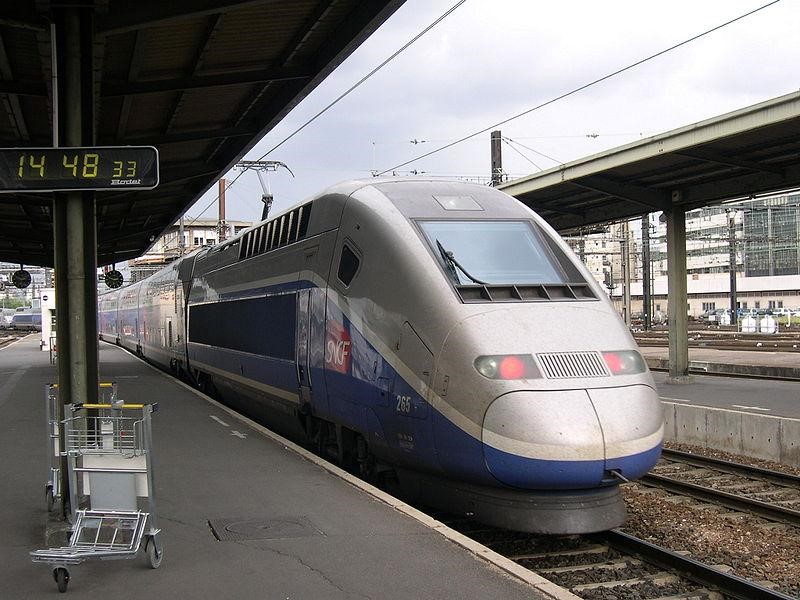
A very simple-looking two-story TGV POS is the fastest serial train. You can touch the legend for only € 25 - the trip from Strasbourg to Paris at a speed of 320 km / h is so much. Source: AlNo / Wikimedia
Rail electric trains could normally work at higher and even maximum achievable speeds, but this is not economically feasible - the energy consumption and engine load will be so great that the cost of train tickets will soar to the level of an airplane business class. The thing is in the good old laws of physics, which are impossible to deceive: the higher the speed of movement, the higher the rolling friction of the wheels, drag and air friction of the whole composition. Air resistance is proportional to the square of the speed of movement, so at speeds above 300 km / h over 90% of the total resistance is precisely air. And the higher the resistance, the more power the engine must develop - it is proportional to the speed cube.
This problem is partially solved by calculating the aerodynamics of the train, reducing the car spacing and reducing the number of bogies (fewer wheelsets — less rolling friction). But ideally, engineers are trying to get rid of at least the wheels, and as a maximum - the air.
Probably everyone knows about the existence of magnetic cushion trains. Someone even knows that the project has existed for a long time, but has not gone into the series. In fact, the first patents for the use of a linear electric motor in railway transport date back to the very beginning of the 20th century, although the levitating maglev in the form in which it came to us was described only in 1959, and was implemented a decade later in Germany within the framework of West German Transrapid project.

The Soviet Union could have its own Muggle in Armenia, but the Spitak earthquake and underfunding of science in the 90s put an end to the project. Source: Andrej Galenko / Wikimedia
The high cost of laying the track (comparable to the deep-laid subway) makes the muggle economically unviable, because its theoretical top speed of more than 600 km / h is justified only at long distances, and the construction of a branch between, for example, Moscow and St. Petersburg will be completely astronomical - if you take as a guide the average cost of laying a metro in Moscow, you get something around 3.25 trillion rubles for the entire line. A modern high-speed rail between two capitals will cost at least half the price .
But there are always countries that do not stand behind the price when it comes to infrastructure projects. Among them, as usual, China: in the 21st century, three short passenger muggles were built in China, in Shanghai, Changsha and Beijing. The speed of the Shanghai magnetic cushion train is 431 km / h, which is significantly higher than that of wheeled trains operated in the world.
Demo of a Chinese Muggle train. Often, spectacular projects do not go beyond the limits of advertising booklets, but the Chinese showed not just a "blank" with seats, but a fully-equipped wagon.
Japan has been experimenting with Muggle for a long time: in 2005, a commercial 9-kilometer branch in the city of Nagoya was launched, and by 2027 it is planned to extend it to Tokyo. Since 2016, a low-speed Muggle has been operating in South Korea from Incheon Airport to the Yongyu recreation center, but in the future the authorities want to significantly expand the network.
Summing up, we can say that the Muggle appeared too early, he was far ahead of his time, but the technology was not forgotten and is returning today.

Indescribable beauty, the Japanese test maglev composition JR Central L0 in 2015 reached a speed of 603 km / h. After the launch of the first branch in 2027, L0 will carry passengers at a speed of 505 km / h. Source: Maryland GovPics / Wikimedia
However, the magnetic cushion solves only one obstacle to increasing train speed - rolling friction. Where air resistance remains a big problem, but enthusiasts are also preparing a council for it. It's about Hyperloop, whose idea was described back in 1909 in the journal Scientific American on behalf of the reader, the future scientist Robert Goddard. In 1941, a Soviet science fiction writer published the novel Arctic Bridge, whose heroes built their own Hyperloop from the USSR to the USA for idealistic purposes of building friendship between peoples. An engineering education helped Kazantsev to describe this underwater transport tunnel in detail and technologically correctly.
We will not once again retell the principle of Hyperloop operation, especially since there is an excellent reference on the topic on Habré. Note that Hyperloop is developed by several independent companies.

One full-size capsule for Hyperloop. Due to the small diameter of the pipes in the passenger capsule, it will be slightly more spacious than in the elevator car. Source: Z22 / Wikimedia
The company Hyperloop TT, attracting volunteers on a free basis, managed to test its capsule and sign several agreements on the construction of passenger lines in the UAE, Saudi Arabia and China. Another company, Virgin Hyperloop One, managed to build a test 500-meter pipe, where she tested the capsule at a speed of 387 km / h.
Although there are many doubts about the viability of such a project (since there were so many projects in the history of revolutionary rail transport projects that did not end there ), do not underestimate the potential of Hyperloop One - the company constantly receives large rounds of financing, the last was the 400 millionth tranche in May 2019.
Test video of the Virgin Hyperloop One XP-1 capsule at 387 km / h. At the current stage, Hyperloop is no better than railways, but this is only the beginning of a long journey.
It is likely that China will again be ahead of everyone with the practical implementation of vacuum trains. Two years ago, the T-Flight train project was introduced, moving through a pipe in an airless space due to magnetic levitation. Even at the initial stage, developers rely on a speed of about 1000 km / h, and in the future it should reach 4000 km / h. Knowing China’s openness to new technologies and almost unlimited possibilities in terms of investments in infrastructure projects, it can be assumed that T-Flight really goes from concept to launch in some ten years.
But, most likely, the fate of Muggle will befall Hyperloop: the technology is again ahead of time, and the real popularization of vacuum trains should be expected well if by the 2050-2060th years.
More “smart”
The advent of computers has given a powerful impetus to the development of rail transportation. Intelligent systems have taken on a lot of complex work on planning the route network, traffic schedules and train composition. For more than a decade, railway operators have been building huge data-processing centers, which are the electronic brain that makes the railway network of the whole country work clearly.
Without computers, scheduling trains is a real headache. In conditions when there was no any powerful computing equipment, databases, wireless communications, and all of this, the development of a route network, the work of arrows and traffic lights required tremendous attention and accuracy. They made a mistake with the arrows or the train was delayed for several minutes - that's all, this little thing is enough to cause chaos and complete paralysis of the railway line instead of organized movement.

This is a single-track train schedule. Now imagine that there are not one, but several tracks, and trains run on different routes more than once per hour, but every two minutes. The computer will cope with the scheduling much faster and most efficiently. Source: eJake / Wikimedia
Nowadays, the operation of railways is increasingly controlled by computers. For example, Toshiba has successfully implemented in Japan, and now offers a railway transportation management complex to the foreign market. It consists of a motion control system, a planning system, and a power management system. We call this a bimodal IT infrastructure that performs two very important tasks at once. Firstly, it increases the stability and efficiency of the functioning of railways, and secondly, it opens up new opportunities and increases the flexibility of the existing railway network.
The motion control system monitors the movement of all trains around the clock, controlling traffic signals and arrows, depending on a given schedule. Monitoring is carried out in real time, and the incident when the train deviated from the schedule and the arrow has already switched to another path is excluded.
The planning system creates an optimal timetable based on the given routes and large data on passenger traffic. The program itself calculates the frequency of trains, the number and type of cars in them, forms a plan for the technical inspection of trains and tracks, calculates the load on personnel and sends this information to all stations in the network.
Finally, the power management system monitors the state of the power grid and controls traction substations.
Given that a computer can take on almost all the functions of a person, the exclusion of the driver from rail transportation in the presence of such monitoring and control systems seems quite logical.
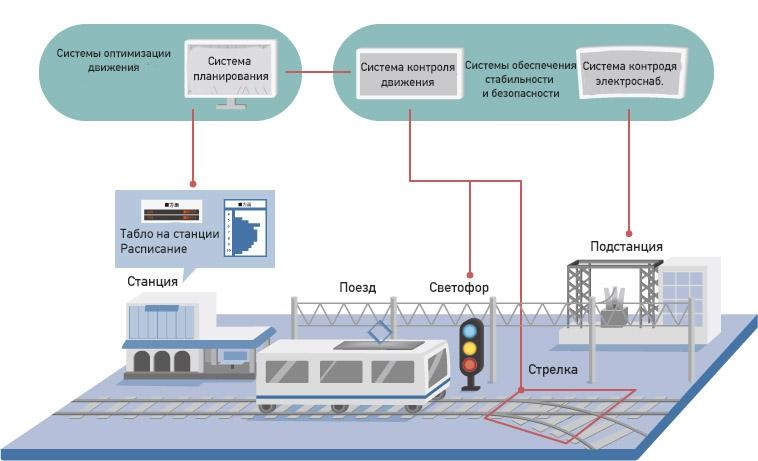
A visual diagram of the operation of control systems in rail transport from Toshiba
Note that we are talking here specifically about the railways, and not about, for example, the subway or people-movuvers (mini-trains at airports, at exhibitions, etc.). There is a lot of autonomous metro where abroad: London and Glasgow, Montreal and Milan, Dubai and even New York, which is known for using OS / 2 in the early 90s to this day.
Unmanned trains, like cars, have autonomy levels from zero to five. For example, the second level implies the presence of a driver who is responsible for the operation of the doors, but not the movement. And at the fourth level, the presence of personnel in the cabin is not necessary, the train itself moves, stops, opens the door and reacts to obstacles. A complete list of countries with fourth-level unmanned trains can be found on Wikipedia.

An autonomous metro train in the city of Kuala Lumpur, Malaysia, developed in conjunction with Siemens, consists of four wagons and seats up to 1,200 passengers. Source: Sirap bandung / Wikimedia
In Russia, trains with an autopilot above the second level are not yet used. In the metro of Kazan and St. Petersburg, the Dvizhenie system has been introduced, which is responsible for the movement and braking of trains, but the driver is responsible for the operation of the doors and monitors possible emergency situations.
Russian Railways plans to launch the first unmanned “Swallow” formations along the Moscow Central Ring in 2021. And this is not about test, but about regular use, since test launches began already in 2019.
On an upbeat note
In 2025, the first passenger railway will turn 200 years old. During this time, the most fantastic projects were born and disappeared, some of which took root and continued the evolution of the railways. Based on economic efficiency, we have chosen the most viable and promising of those that are likely to determine the future of rail transport a century ahead. Perhaps not all of them will find practical implementation, and Hyperloop will remain a science fiction dream for a long time to come, but automation and general “smartening” of railways all over the world will inevitably happen.